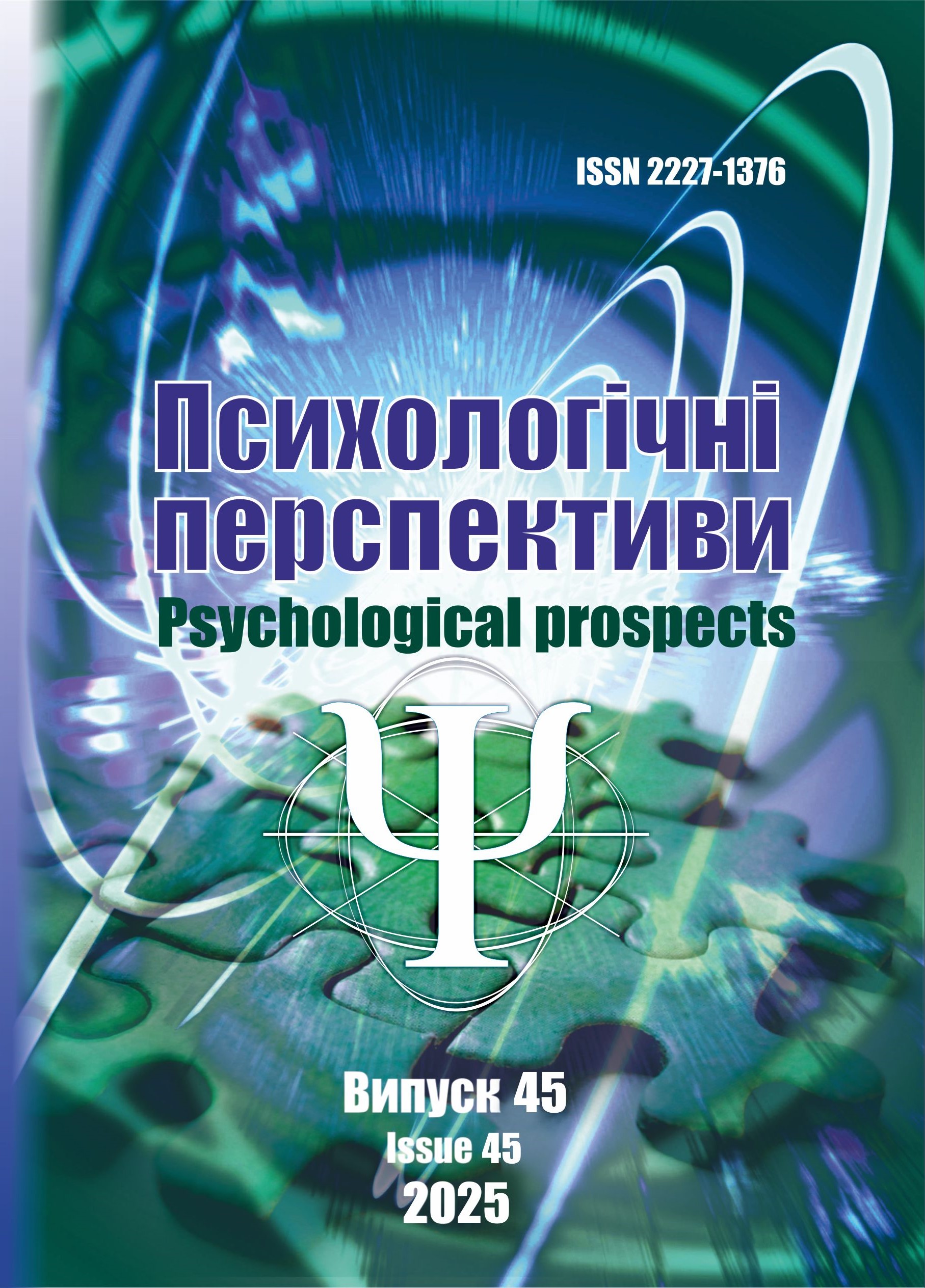Manifistations of Continuous Traumatic Stress Among Adolescents in War
DOI:
https://doi.org/10.29038/2227-1376-2025-45-solKeywords:
continuous traumatic stress, adolescents, depression, anxiety, sleep qualityAbstract
Purpose. The aim of this study is to examine the psychological characteristics of adolescents' experiences of war-related trauma, with particular attention to symptoms of continuous traumatic stress (CTS), post-traumatic stress disorder (PTSD), depression, anxiety, loneliness, and sleep disturbances.
Methods. The study involved 485 adolescents aged 12 to 18. Standardized diagnostic assessment tools were used: The Continuous Traumatic Stress Response scale (CTSR), the Child PTSD Symptom Scale for DSM-5 (CPSS-5), the Patient Health Questionnaire (PHQ-9) for depression, the Generalized Anxiety Disorder scale (GAD-7), the Pittsburgh Sleep Quality Index (PSQI), the UCLA Loneliness Scale. Statistical analysis included descriptive statistics, correlation, and linear regression analyses.
Results. The findings reveal high psycho-emotional vulnerability among adolescents living in wartime conditions. Clinically significant symptoms of depression were found in 25.6% of participants, anxiety in 20.8%, PTSD in 28.2%, and sleep disturbances in 43.9%. Correlation analysis indicated strong associations between CTS and depression (r = 0.85), anxiety (r = 0.79), PTSD (r = 0.78), and sleep quality (r = 0.56). Linear regression revealed that depression, PTSD, and anxiety were the robust predictors of CTS, while loneliness and sleep quality were not independently significant. The overall regression model is significant, p<.001.
Conclusions. Adolescents exposed to war experience have poor psycho-emotional effects. Depression, anxiety, and PTSD are the key factors contributing to the development of CTS. These findings underscore the urgent need for targeted psychosocial support programs focused on the prevention of chronic stress and the stabilization of adolescents' emotional states in crisis conditions during war.
References
1. Bayer C. P., Klasen F., Adam H. (2007). Association of trauma and PTSD symptoms with openness to reconciliation and feelings of revenge among former Ugandan and Congolese child soldiers. The Journal of the American Medical Association, 298, 555-559. https://doi.org/10.1001/jama.298.5.555. DOI: https://doi.org/10.1001/jama.298.5.555
2. Eagle, G., & Kaminer, D. (2013). Continuous traumatic stress: Expanding the lexicon of traumatic stress. Peace and Conflict: Journal of Peace Psychology, 19(2), 85. https://doi.org/10.1037/a0032485 DOI: https://doi.org/10.1037/a0032485
3. Foa, E. B., Asnaani, A., Zang, Y., Capaldi, S., & Yeh, R. (2017). Psychometrics of the Child PTSD Symptom Scale for DSM-5 for Trauma-Exposed Children and Adolescents. Journal of Clinical Child & Adolescent Psychology, 47(1), 38–46. https://doi.org/10.1080/15374416.2017.1350962 DOI: https://doi.org/10.1080/15374416.2017.1350962
4. Goral A, Feder-Bubis P, Lahad M. et al. (2021) Development and validation of the Continuous Traumatic Stress Response scale (CTSR) among adults exposed to ongoing security threats. PLoS ONE. 16(5). https://doi.org/10.1371/journal.pone.0251724. DOI: https://doi.org/10.1371/journal.pone.0251724
5. Gušić, S., Malešević, A., Cardeña, E., Bengtsson, H., & Søndergaard, H. P. (2018). “I feel like I do not exist:” A study of dissociative experiences among war-traumatized refugee youth. Psychological Trauma: Theory, Research, Practice, and Policy, 10(5), 542. https://doi.org/10.1037/tra0000348. DOI: https://doi.org/10.1037/tra0000348
6. Joshi, P. T., & O'donnell, D. A. (2003). Consequences of child exposure to war and terrorism. Clinical child and family psychology review, 6, 275-292 DOI: https://doi.org/10.1023/B:CCFP.0000006294.88201.68
7. Kira, I. A., Ashby, J. S., Lewandowski, L., Alawneh, A. W. N., Mohanesh, J., & Odenat, L. (2013). Advances in continuous traumatic stress theory: Traumatogenic dynamics and consequences of intergroup conflict: The Palestinian adolescents case. Psychology, 4(04), 396. http://dx.doi.org/10.4236/psych.2013.44057. DOI: https://doi.org/10.4236/psych.2013.44057
8. Kroenke K, Spitzer RL, Williams JB. The PHQ-9: validity of a brief depression severity measure. J Gen Intern Med. 2001 Sep;16(9):606-13. https://doi.org/10.1046/j.1525-1497.2001.016009606.x. DOI: https://doi.org/10.1046/j.1525-1497.2001.016009606.x
9. Mollica, R. F., Poole, C., Son, L., Murray, C. C., & Tor, S. (1997). Effects of war trauma on Cambodian refugee adolescents' functional health and mental health status. Journal of the American Academy of Child & Adolescent Psychiatry, 36(8), 1098-1106. https://doi.org/10.1097/00004583-199708000-00017. DOI: https://doi.org/10.1097/00004583-199708000-00017
10. Okello, J., De Schryver, M., Musisi, S., Broekaert, E., & Derluyn, I. (2014). Differential roles of childhood adversities and stressful war experiences in the development of mental health symptoms in post-war adolescents in northern Uganda. BMC psychiatry, 14, 1-8. https://doi.org/10.1186/s12888-014-0260-5. DOI: https://doi.org/10.1186/s12888-014-0260-5
11. Pat-Horenczyk, R., & Schiff, M. (2019). Continuous traumatic stress and the life cycle: Exposure to repeated political violence in Israel. Current Psychiatry Reports, 21, 1-9. https://doi.org/10.1007/s11920-019-1060-x. DOI: https://doi.org/10.1007/s11920-019-1060-x
12. Sfeir, E., Geara, C., Hallit, S., & Obeid, S. (2020). Alexithymia, aggressive behavior and depression among Lebanese adolescents: A cross-sectional study. Child and adolescent psychiatry and mental health, 14, 1-7. https://doi.org/10.1186/s13034-020-00338-2. DOI: https://doi.org/10.1186/s13034-020-00338-2
13. Solomon Z., Lavi T. (2005). Israeli youth in the second intifada: PTSD and future orientation. Journal of the American Academy of Child & Adolescent Psychiatry, 44, 1167-1175. https://doi.org/10.1097/01.chi.0000161650.97643.e1. DOI: https://doi.org/10.1097/01.chi.0000161650.97643.e1
14. Sourander, A., Silwal, S., Osokina, O., Hinkka-Yli-Salomäki, S., Hodes, M., & Skokauskas, N. (2024). Suicidality and self-harm behavior of adolescents during the early phase of the war in Ukraine. Journal of the American Academy of Child & Adolescent Psychiatry, 63(12), 1204-1214. https://doi.org/10.1016/j.jaac.2024.03.015. DOI: https://doi.org/10.1016/j.jaac.2024.03.015
15. Suliman, S., Mkabile, S. G., Fincham, D. S., Ahmed, R., Stein, D. J., & Seedat, S. (2009). Cumulative effect of multiple trauma on symptoms of posttraumatic stress disorder, anxiety, and depression in adolescents. Comprehensive psychiatry, 50(2), 121-127. https://doi.org/10.1016/j.comppsych.2008.06.006. DOI: https://doi.org/10.1016/j.comppsych.2008.06.006
16. Zasiekina, L., & Martyniuk, A. (2025). War-related continuous traumatic stress as a potential mediator of associations between moral distress and professional quality of life in nurses: a cross-sectional study in Ukraine. BMC nursing, 24(1), 16. https://doi.org/10.1186/s12912-024-02668-4 DOI: https://doi.org/10.1186/s12912-024-02668-4
17. Zasiekina, L., Goral, A., Fedotova, T., Akimova, A., & Martyniuk, A. (2024). Cross-cultural adaptation and psychometric validation of The Continuous Traumatic Stress Response Scale: Ukrainian version. East European Journal of Psycholinguistics, 11(1), 156. https://doi.org/10.29038/eejpl.2024.11.1.zas DOI: https://doi.org/10.29038/eejpl.2024.11.1.zas
Downloads
Published
Issue
Section
License
Copyright (c) 2025 Olena Solonenko

This work is licensed under a Creative Commons Attribution-NonCommercial 4.0 International License.






